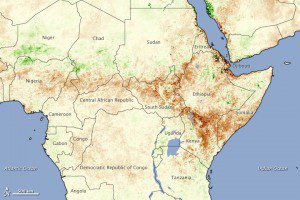
Brown areas indicate sparser crop growth April-June 2011, leaving 11.5 million inhabitants in need of food.
Drought has plunged East Africa into the worst food security crisis Africa has faced in 20 years. More than 11.5 million people are currently in need of food aid in Djibouti, Kenya, Somalia and Ethiopia. The number is projected to rise, and this image illustrates why.
The image shows plant growth during the growing season for the crop normally harvested in June and July. The image was made with observations from the Advanced Very High Resolution Radiometer (AVHRR) on the NOAA-18 POES satellite, which records the amount of light plants in a broad region absorb during photosynthesis. Where there were more leafy photosynthesizing plants than average, the image is green. Brown indicates that plants were sparser or growing less than average. Broad swaths of East Africa are brown, pointing to poor plant growth during the growing season.
The crop grown during this period is typically planted in March or April, when the first rains of the year fall. In 2011, the rains were late, falling in late April and May, and inadequate. The crops were planted late and are only now being harvested. In southern Somalia, currently the most severely impacted region, the harvest is expected to be 50 percent below average, according to the Famine Early Warning Systems Network (FEWS NET). Pastures are also sparse, putting stress on livestock.
The poor harvest and lack of pasture in July compounds existing food security problems. The previous crop, harvested early in the year, was also poor. In Somalia, the harvest was less than 20 percent of the average harvest, and people began to run short on food in April. Another bad harvest reduces food availability even more, which means that food prices will likely rise more in the coming months.
On July 20, the United Nations declared a famine in parts of southern Somalia, where 2.8 million people are in need of life-saving assistance. Surrounding regions in Somalia, Ethiopia, Kenya and Djibouti are in a food crisis or food emergency. The United Nations declares a famine only when at least 20 per cent of households in an area face extreme food shortages with a limited ability to cope; acute malnutrition rates exceed 30 per cent; and the death rate exceeds two persons per day per 10,000 persons.
During the last three months, tens of thousands of people have died in Somalia, and, as the image shows, the current harvest is unlikely to bring relief. Based partly on satellite images like this one, FEWS NET predicts that famine conditions will spread across all of southern Somalia in the next month or two.
The food security crisis is the worst since 1991-1992, according to FEWS NET. The drought behind the crisis is the worst in the region in the last 60 years, with some areas experiencing one of the driest years on record. The drought is tied to the strong La Niña conditions that prevailed in late 2010 and early 2011. La Niña shifts ocean temperatures and air pressure over the Pacific Ocean, and its effects ripple through weather patterns around the world. In East Africa, La Niña causes drought. La Niña conditions have ended, and FEWS NET predicts normal rains for East Africa later in the year, though it will take far longer for the region to recover.
NASA Earth Observatory image created by Jesse Allen, using data provided by the U.S. Department of Agriculture Foreign Agriculture Service and processed by Jennifer Small and Assaf Anyamba, NASA GIMMS Group at Goddard Space Flight Center. Caption by Holli Riebeek.

